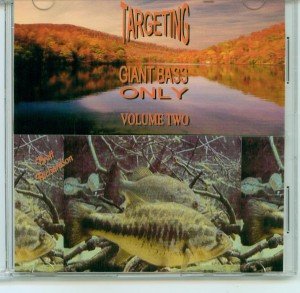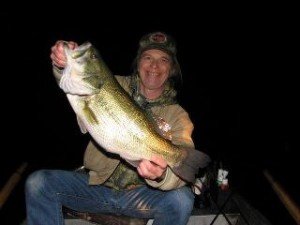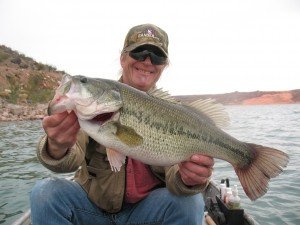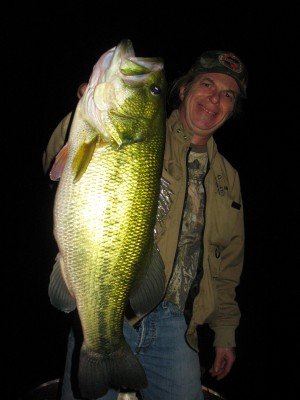 Season within season, chasing giant large mouth and small mouth bass during night hours offers you the chance to increase your total numbers of the largest bass in any system more than 60% no matter where you fish.
Season within season, chasing giant large mouth and small mouth bass during night hours offers you the chance to increase your total numbers of the largest bass in any system more than 60% no matter where you fish.
Brett’s bass fishing at night
In this piece, veteran trophy bass hunter and stealth night fishing specialist Brett Richardson, examines the predominant season with season aspects of targeting monster bass taking you through an entire season on the water. Migrations, Locations, weather elements, bite window increments, vertical post-front bassing and the stacking factor, zoning A-D column bass locating throughout the entire water column, along with calculating prime time pre- moon phase bite windows are all pieces of the puzzle to boat huge bass consistently.
- Decades have passed by quickly since my first night bass fishing excursion back in the 1950’s. My first giant bass surpassing 7 lbs crushed a Jitterbug during the prime peak bite night hours during one of my childhood bass hunts. My first Article on night fishing tactics was published in the mid 80’s. One Thing has not changed since then. This quiet time still offers the best opportunity to take out-size Largemouth and Smallmouth bass on any waters you target across the United States and Canada from Spring through Fall.
- Learning to recognize season within season changes, daily and seasonal movements, locations and positions in the water column, along with learning to recognize activity levels will aid in taking giant bass on a consistent basis.
- Prime Bite windows still occur during the same specific time frames throughout the calendar year. The same approach to targeting giant bass specifically with the addition of modern baits and some old ones still remain the key to success in your quest for monster bass.Learning the entire night fishing program on a season within season basis is crucial, and will aid in taking huge bass throughout the year..Adapting to the subtle time changes when peak bite windows occur through each seasonal change during variable water temperatures, specific weather windows, and certain time frames such as pre-front, post-front, quick or subtle barometric changes and learning the reaction of the largest bass in the systems you fish to each of these scenarios, will keep you focused and will keep you on correct locations for giant bass.
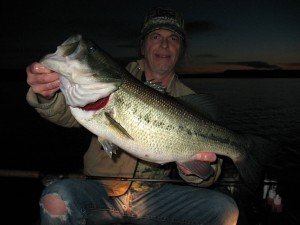
- Targeting the correct zones and precise locations of giant bass in the water column during the toughest time frames of the season and using the proper precise presentations for each group, or solitary fish, is essential for taking big fish at any time throughout the season. Lets examine the season within season concepts, peak water temperatures for each scenario, and particular baits and presentations to help you be successful.
- My night bass fishing excursions begin in mid-spring, usually before most anglers even think about the night bite. During mid April, in most parts of the country when water temperature gets into the the 50 to 58 degree range, giant pre-spawn females on migration routes to spawning areas may congregate on basin ledges just before the pre-spawn peak bite.These fish can congregate in large groups for the stage, or single solitary giants can choose specific areas in basin channels, ledge areas, and edges of spawning flats closest to the deepest water in the system. Groups of fish can be picked off in large numbers and the lone giants might be the heaviest bass you have ever taken.Most of the Larger fish in any system locate near, or on, the deepest breaks and are moving in from main lake basin areas after wintering. These are the first early pre-spawn fish that are just starting to set up on these locations after a long winter. These movements vary depending on regional locations across the country based on various water temperatures.
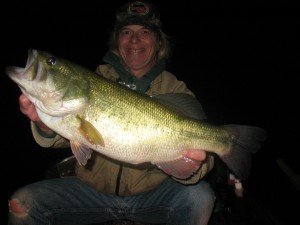
- During the day, many of these early pre-spawn giants can be found suspending at various depths in the water column. Some will set up away from structure, but move up on it, or close to it, during the late afternoon and dusk time frames.
- Just weeks after ice-out on impoundments that freeze over, early spring warming trends during stable conditions, not interrupted by barometric change, trigger movements to pre-spawn staging locations. Typically, a strong south wind will trigger these movements and the Northwestern sections on the waters you fish can hold numbers of giant early pre-spawners. This is prime time to start hunting for early season monsters at night. The big bass bite at this time of the season can start as early as late afternoon into early evening and continue through the night, depending on water temperature and regional location. There are short peak bite windows that will occur. During the early part of my night fishing season, the dusk period creates a short primary bite window.
- The early season prime night bite can vary, but dusk through 10:00 pm and up until 1:00 am is usually prime time at this first stage of the Spring season. On Early Spring Overcast days, the late afternoon through dusk time frame is prime time for triggering multiple sows that have been pushed up into pre-spawn feeding zones from Southerly winds that can raise water temperatures slightly in the Northern sections of lakes and reservoirs after a few stable days with rising air temperatures. The incoming frontal conditions after warm stable weather creates a peak bite window for early spring giants.
- In April of 2009, this exact scenario occurred n one of my favorite reservoirs. Strong Southerly winds persisted during the afternoona quick barometric change with overcast skies and drizzle produced a 5.5 and 6.8 leer just before dusk. As every other boat headed for the launch, the skies darkened more, and we headed for the ledges and secondary breadlines at the North end of the reservoir.On 4 consecutive casts, a 6.4, 5.9, 6.9 and 9.3 came to the net. This bite window peak happened within a 12 minute period! We also had another big fish become unbuttoned at boat side. This scenario happened with water temps at just 48 to 50 degrees. This early season, cold water pre-spawn bite window was just an example of what can occur throughout the entire night fishing season. This was an example of an early in the season option for big fish, even before the actual pre-spawn chomp is in full gear.

- Hot baits for this super early season night bite include: Swim Jigs with down-sized plastic or pork trailers, larger craw tubes or tobie Tubes rigged on a split-shot rig,, Heavy hair jigs for fishing deeper ledge areas and break lines, ½ to 1 oz standard jigs with plastic craw or pork trailers, ½ to ¾ oz short-arm spinnerbaits, ½ to 1 oz football Jigs with trailer of choice, drop-shot rigs with over-sized craw trailers, Jumbo plastic craws rigged on a Lindy no-snag rig or Carolina rig, 4 to 5 inch Hula Grubs rigged on a drop-shot rig or Mojo Rock Hopper rig and various swim jig combos. Drifting a jumbo craw with on a sand bag rig, three way rig, or Carolina rig has helped me boat numbers of giant bass pelagic drifting structures during the early season through late Fall in higher wind conditions.
- These rigs have produced huge numbers of giant Largemouth and Smallmouth over the years, including fishing the Great Lakes early trophy season time frame for huge smallies. You’ll need your heavier versions of these baits and rigs to accommodate windy conditions and to be able to detect subtle pick-ups in deep water. Many of the larger bass in the system will inhale baits on the fall in cold water.If fish start to move up on the edges of flats, break out your arsenal of rattle baits and suspending Jerk-Baits.As water temperatures warm into the 52 to 60 degree range, the night bitebecomes more consistent. The Pre-Spawn Night bite can be on fire before the surface temp even hits 62 degrees. Most anglers wait until at Least early Summer time frame to target these fish at night, so boat traffic can be minimal. Early to Mid-Spring Nights can be cold depending on geographical locations, so dress accordingly for the early season night bite.The Next stage of the night bite gets even hotter as water temps rise past the 60 degree mark. More and more of the largest females in the system are now moving within closer proximity to spawning areas, some early spawners have moved toward beds. Although many fish are not spread across flats yet, they are moving toward them. Since the spawning ritual occurs in increments, many giant bass will still be staging on break-lines, ledge areas, and at the lip of main lake basins. Target subtle depressions in bottom contours that lead toward spawning grounds.
- These fish are still deep and on the tail end of travel routes. These depression areas may only be a few feet deeper than the basic staging area bottom depths, but can hold numbers of big females. A difference of a few feet in small areas will hold staging fish. If your in 34 feet of water for example, and the bottom contour slopes into 38 to 42 feet in a small zone, this can be a perfect holding place for incoming giants. Ant travel Route section of the water you fish that leads to hard bottom and located near the edges of expansive flats can hold large numbers of big fish during the pre-spawn time frame.Once water temps are in this range, males congregate and are integrating in some of the same locations. More numbers of smaller males are now more apt to take the same baits and presentations, though you will still boat plenty of giant pumpkin-bellied females.
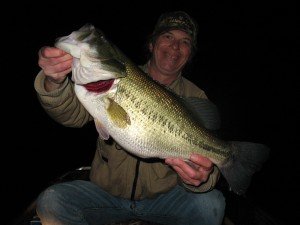
- These Spring nights bode well for multiple trophy size bass. During this time frame, I stick to the same baits and presentations, but add swim baits to my night arsenal. Big Females are staring to see more bluegills and trout in staging zones. At times, I’ll down-size my swim baits to 5 and 6 inch models. Using bluegill and trout profiles and color schemes always will pull some out-size fish during the pre-spawn peak bite. Once this bite kicks in, your big bass numbers can be extreme.As the water temperatures rise to the mid-sixties and stays there, a good number of bass are now up on beds, as others remain in pre-spawn mode.
- Smallies bed first, sometimes with temps still in the 50’s. Personally, I continue to target the backed-off pre-spawners at this time, although I don’t mind if a jumbo spawner takes one of my presentations as I fish parallel to spawning areas off the breaks. Same baits apply here, but it’s time to add top water baits to your arsenal. Baits like a Poppin’ Image . Spittin’ Image or Skitter Pop, along with some old standard top water baits account for many of my out-size bass during this prime seasonal peak. These baits will tempt pre-spawn fish and fish bedding near structures and up on flats. Wake-Baits will also come into play. I’ve had staging fish come up from 20 feet or more to take top water baits or wake-baits on some of the gin clear waters here in the Southwest.
- If the spawning areas have bushes, trees or tulies, frog baits take their share of Jumbo Largemouth and smallies that are staging or bedding near cover. As the primary initial spawn peaks, so does the night bite. Water temps are warm enough to target fish at variable depths throughout the entire system. Many anglers target spawning fish and sight fish during the day at this time of the season, but I find that the night bite excels for big bass in various stages. The night bite is on to trigger vicious strikes from all locations.Jig combos, spinnerbaits, swim baits, tubes, top water baits, crank baits, rattle baits, plastics, and Jerk baits will all take their share of big fish. Fine tuning your presentation for each location of bass throughout the entire water column is critical to trigger bites during varying weather conditions. Dead-Sticking baits on bottom or for fish in stacked vertical position that suspend in situations like post-front scenarios, can be a crucial factor in triggering bites from obstinate bass.
- With the spawning time frame progressing into the later stages, first round post-spawn bass will begin to feed heavily after recovering and attack baits as well. I don’t believe in the post-spawn doldrums at all. I’ve taken fish right through the entire season, and post-spawn fish have taken baits as well. I’ve never had a problem triggering post-spawn bass to bite on any waters I’ve fished throughout the country. They might look beat up and skinny, don’t make great photos, but they are still as eager to take the proper presentations.The Next stage is the Summer peak Period. This is one of my favorite times of the season to night fish, as every bass in the system is on a quest to crush baits. Water temperature between 68 and 74 degrees, in most parts of the country signifies the Summer Peak. During the Summer Peak, all bass are active and giant bass can be boated in huge numbers. Over all numbers of various size bass make up an 8 hour night excursion and bass fishing is just plain fun.
- As late a June in many parts of the country, second and third round spawners may still be spawning as older fish seem to spawn at later times during late Spring Through Summer Peak. The recovered post-spawners from the initial first round group are now gorging themselves and every bass in the system are chomping everywhere in the system. I’ve Taken big numbers of out-size fish on any system I’ve fished throughout the country during this Summer peak short time frame that usually lasts about 2 to 3 weeks.This early Summer feeding explosion is Summer Peak fishing at it’s finest. Depending on the Geographical Location that you live in, Late May through mid to late June can offer the prime time Summer peak Explosion.

- This is my favorite time frame to fish buzz baits over deep flats, work vertical deep swim jigs and short-arm spinner baits. Bass will hit almost anything, but I prefer targeting giant fish only which forces me to fish with big fish baits and presentations that have kept me taking giant bass consistently for more than five decades. The Approach is to stay completely focused on Big Bass Migrations, learn the zones the use throughout the entire season, be able to recognize when to change up and tweak your presentations and virtually fit in with the world of giant bass. The Summer Peak Prime Bite windows usually start around 11:00 to 11:30 PM and again from 1:30 AM Through 3:00 AM.The one hour before dawn usually triggers a 45 minute to 1 hour bite before sun up. The Summer Bite peak time bite windows adjust to later time frames as the Summer peak switches to early through mid Summer and again during the later part of Summer, just before turnover. I follow a strict regimented time schedule for these varying peak bite windows each season within season. I’ve narrowed it down even further and have my time schedules for prime bite windows logged for 5 decades on the water at night. My Summer peak prime time slots: 8:00 PM til 10:00 PM . 11:30 PM through 1:45 AM, 2:30 am through 3:00 am and, 4:00 am until 5:00 am.
- As the Summer stages progress to the mid stages, prime bite windows occur at 11:30 pm until 2:45 am. Late Summer: 8:30 PM til 10:00 pm, then 1:30 am til 3:30 am.
- During fall turnover, the bite windows are shorter, but dusk til 11:00 pm and 1:00 am to 2:30 am have been the most productive through the deacdes. These times are all logged into my bass logs and journal and have worked for more than 50 years. After being a night fishing addict for this long, all the seasonal bite windows are etched into memory banks. If I look back through all my logs through the decades, 88.7 percent of my largest Northern Strain Bass have bit during these exact bite windows through the night fishing season.
- The Summer peak Bite will vary across the country depending on exact geographical Locations and water temperatures. In The Northeast, Summer peak was the 3rd week of May through mid-to late June. In The Mid-West Bass season doesn’t even open until late June, which the start of their summer peak bite anyway. Here in the Southwest, it’s all depending on elevation, it can start in Early May in Texas , late April / Early May in Southern California, and here in Nevada and Southern Utah it can start anywhere from Early May til June 1st depending on the exact elevations of the waters you target, and just a few weeks before daytime air temps hit the 100 degree mark.
- The Mid-Summer time frame after the Summer peak is usually hot everywhere, and here the Southwestern part of the country, blazing sun can harm you skin or kill you. Perfect time to launch as late as possible and fish til dawn. I’m off the lake an hour before sun-up and find shorter bite windows, as I sated earlier, but still boat good numbers of big fish. The night fishing scenario bodes well through mid-Summer for avoiding Heavy boat traffic and big bass choose to feed less but during lower light conditions.Fishing slows down a bit from Summer Peak of course, but we’ve had phenomenal Mid-Summer fishing here for the past 7 years. In the deep clear Canyon reservoirs, I spent most of my prime bite window time frames chasing Off-Shore Pelagic Giants, that hoard bluegills, trout, shiners, or crawdads. These fish suspend a lot at A – D group positions in the water column, feed less but can be located easily.Presentations must be perfect.The Pelagic Chase lasts through turnover and even until Late Fall Consolidation time frame. These min lake deep fish are strong, feisty BIG fish through the hottest part of the season but bite windows will be a bit more narrow. Follow the fore mentioned time zones to stay at the depths and vertical and horizontal depth locations and you’ll be able to stay on the largest fish in the system all through the entire night season.
I usually don’t get on the water until about 10:30 to 11:00 PM during this period of the season, get set up, and head for my favored off shore haunts and mid-Lake structures. As I discussed in “ Crankin’ The Humps For Summer Bass “ in the August 2009 Issue of In-Fisherman, strolling these main lake basin areas, off-shore humps and primary deep water structures, takes precedence over any other tactic I use during at this time of the season chasing both giant Largemouths and huge smallmouths.
For This scenario, My Rods are rigged with 5/8 to 1 oz fast sinking swim jigs and swim baits in the 6 to 8 inch variety. Another 2 rods are rigged with a 1 oz football jig n’ craw combo and a standard 7/8 oz Northland Jungle Jig and old # 27 Crawfrog. Short-arm Spinnerbaits in the ½ to 1 oz. are my final baits to work straight vertical presentations for off-shore giants locating at variable depths.
For Fish riding higher in the water column feeding on Bluegill pods, a wake-bait or large walking bait are fun options. Another bait I’ve added recently to the Mid-Summer Stealth night excursions is a Spro bucktail jig in the 1 oz range with a 5 inch grub trailer. I prefer a Bluegill Pattern Kalin’s Mogambo grub or a large rattle grub on the back of my bucktails.
This is a productive combo for working around mid-lake structures where bluegill pods congregate and giant bass feed in the late night / early morning hours. Gator Tail style of grubs on a bucktail or swim jig in green or blue / Orange patterns have produced well for me from Mid to Late Summer and even through fall.
From Late Summer Through Mid-September there are quite a few changes that occur. Bass sense a need to feed as the turnover first begins. This is usually from Late August through mid-September for about a three week period. As the surface temperature can start to drop in certain parts of the country by mid-September bass sense the coming of fall and spread out a bit more through basin areas.
As the Fall turnover starts, slowly big bass that were inhabiting shallow weed bed ares, expansive flats, and coontail or hydrilla, move out to edges as oxygen starts to deplete gradually through the fall turnover. Follow these early Fall migrations to stay on these fish.
During the Start of turnover and right through turnover I’ve seen big bass come up and blast Bluegills between 1:00AM and 3:00 AM across main lake basins and around off-shore structures. Fish can be up or down over 45 to 70 feet of water on these deeper clear water impoundments.
These are suspending fish locating at various depths that are on suspending forage. This has been a common scenario on deeper lakes and reservoirs for largemouth and smallies across the country. Forage base depends on which water you are targeting.
Some chase rainbow trout, bluegill, shiners, alewives, emerald shiners, red-tail chubs, whatever their primary forage is on a specific body of water. This is a time when I like to cover a lot of water and pinpoint certain active groups of fish or solitary feeders during primary bite windows.
As the nights get cooler and the water temperature continues to fall, this signifies the official start of Fall Turnover. Just before this occurs, the bite increases for the larger fish in the population. Here, In the Southwestern Reservoirs, an early Fall feed starts in mid to late September and peaks through the entire month of October and into mid November on certain years depending on the weather conditions in the higher elevation lakes.
The Entire Fall season right up through the Fall consolidation has been incredible through the past 6 or 7 seasons for big numbers of out-size Northern Strain Bass This includes both Northern Strain largemouth and big smallies. The Fish are spread out across the main lake basins and now are once again back on main basin migratory routes on route to selecting specific consolidation areas. Once these groups are located,
The Fall Peak night bite produces multiple big fish nights on almost every trip. This Fall peak extravaganza can start as early as dusk and last on and off until about 2:30 am if the weather permits. Usually the multiple big fish bite is again, consolidated into 2 hour bite windows. During the Fall consolidation period, we have had nights where a 7 big fish total surpassed the 42 lb mark during short bite windows of 40 minutes or less!
Peak time for this scenario is when water temps drop from 58 to 52 degrees in most parts of the country. Here in the Southwest, it starts at 62 dropping to about 55 degrees. This offers about a 3 or 4 week window for giants as they consolidate to specific areas on any waters you target.
The Fall Peak night bite can last here in the Southwest until night time air temperatures drop into the 20’s and 30’s, which usually lasts until mid to late November on the high elevation Canyon Reservoirs.
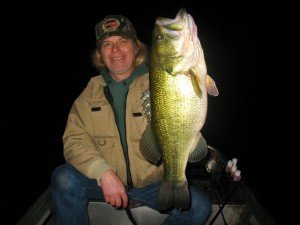
In The Northeast and Midwestern areas of the country, the Fall peak bite calendar period is a month earlier time frame than here in the Southwest, bit coincides with the same water temperature. As the season gets toward tail end, bait choices get even simpler. A few rods rigged with various weight jig combos, A rod rigged with a rabbit hair jig or bucktail combo, a short-arm spinnerbait rigged with a 4 inch trailer, a rod rigged a soft plastic craw or sweet beaver style bait, and a clacker style spinnerbait or swim jig combo will cover all the depths and presentations you’ll need to trigger consolidated late Fall Bass.
- Use moon phases the same way you use them all season. I find that from the latter part of the Summer right through fall peak, that the New moon phase out produces the full moon during these time frames. Fish both phases 5 days before and up until the official moon in both instances. Giant bass feed heavily before the official moon and are usually gorged by the day of the official full or new moon.Again this synopsis is based on data kept for more than 5 decades on the water bass hunting during every condition possible.This Late fall Time Frame can turn out even better numbers of out-size fish then even the prime pre-spawn bite and Summer Peak time Frame, and by now the majority of anglers are out Hunting…. In Mid-To Late Fall, show up at the launch just before dusk as an early bite window occurs most times.Stay Warm and Focused during colder air temperatures and possible high winds. Keep your electrolytes in balnce to help in staying focused. Depending on wind direction, the air temperature can be brutal at times, but the giant Bass Don’t Care. Moon’s up, Boats Loaded, I’m Outta here……….
Spring Bass Fishing for Giants
*Safety Tips For Stealth Night Trips
- 1] Scout all waters you are planning to target at night during the day to locate specific structures and obstacles that might cause safety issues.
- 2] After and 8 or 9 hour Night Trip, don’t risk driving long distances when exhausted .
- 3] When Hanging baits, go over to where the bait is hung and remove it from a straight down position. * Boat lights help other boats on the water see you. Keep both running lights on during night excursions.
- 4] Have Your boat meticulously organized before hitting the water. Lights and nets in place, Batteries properly stored, rods rigged and ready by stowed away. Organize everything in it’s proper place to avoid tripping or falling.
- 5] During cold, hot or windy conditions, have plenty of hot or cold fluids, keep your electrolytes in balance, stay hydrated. This will help you think clearly and totally focus on the task at hand.
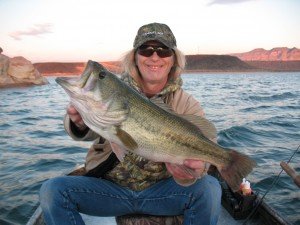
*About The Author – Veteran Trophy Bass Hunter, Freelance Outdoor Writer, and In-Fisherman Contributor Brett Richardson has been chasing Multi-Species giant fish for more than five decades. He offers a season within season specialty Giant Bass Collection of 13 dvds covering seasonal tactics for taking out-size Largemouth and Smallmouth Bass. Visit his website @ Brett Richardson’s giantfish.com and e-mail @ [email protected] for any Dvd orders.